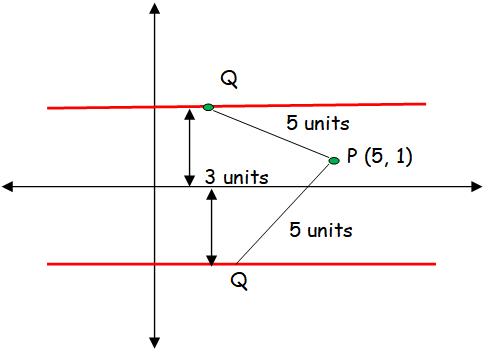HOW TO FIND EQUATION OF LOCUS OF A POINT WITH THE GIVEN DISTANCE
Example 1 :
Find the points on the locus of points that are 3 units from x-axis and 5 units from the point (5, 1).
Solution :

Let Q be (h, k)
- If the required point above the line, then it would be in the form (h, 3)
- If the required point above the line, then it would be in the form (h, -3)
PQ = 5
P (5, 1) Q (h, 3)
PQ = √(x2 - x1)2 + (y2 - y1)2
√(5 - h)2 + (1 - 3)2 = 5
√((5 - h)2 + 4) = 5
Taking squares on both sides, we get
(5 - h)2 + 4 = 25
(5 - h)2 = 25 - 4
(5 - h)2 = 21
(5 - h) = √21
h = 5 ± √21
If the point is in above the line, then the required points would be (5 + √21 , 3) or (5 - √21 , 3)
P (5, 1) Q (h, -3)
PQ = √(x2 - x1)2 + (y2 - y1)2
√(5 - h)2 + (1 + 3)2 = 5
√((5 - h)2 + 16) = 5
Taking squares on both sides, we get
(5 - h)2 + 16 = 25
(5 - h)2 = 25 - 16
(5 - h)2 = ±9
(5 - h) = ± 3
h = 5 - 3 (or) h = 5 + 3
h = 2 (or) h = 8
If the point is in below the line, then the required point will be (2 , -3) or (8, -3)
Example 2 :
The sum of the distance of a moving point from the points (4, 0) and (−4, 0) is always 10 units. Find the equation of the locus of the moving point
Solution :
Let P(h, k) be the moving point
Let A (4, 0) and B (-4, 0)
PA + PB = 10
√(h - 4)2 + (k - 0)2 + √(h + 4)2 + (k - 0)2 = 10
√(h - 4)2 + k2 = 10 - √(h + 4)2 + k2
Taking squares on both sides,
(h - 4)2 + k2 = 100 - 20√(h + 4)2 + k2 + (h + 4)2 + k2
h2-8h+16+k2=100-20√((h + 4)2+k2)+h2+8h+16+k2
-16h - 100 = -20√((h + 4)2+k2)
4h + 25 = 5√((h + 4)2+k2)
By taking squares on both sides, we get
16h2 + 200h + 625 = 25 (h2 + 8h + 16 + k2)
25h2-16h2 + 25k2 + 200h - 200h + 400 - 625 = 0
9h2 + 25k2 - 225 = 0
9h2 + 25k2 = 225
Divide by 225
h2/25 + k2/9 = 1
By replacing h and k by x and y respectively, we get
x2/25 + y2/9 = 1
Kindly mail your feedback to v4formath@gmail.com
We always appreciate your feedback.
©All rights reserved. onlinemath4all.com
Recent Articles
-
Digital SAT Math Problems and Solutions (Part - 150)
Apr 25, 25 11:46 AM
Digital SAT Math Problems and Solutions (Part - 150) -
AP Calculus AB Problems with Solutions (Part - 19)
Apr 24, 25 11:10 PM
AP Calculus AB Problems with Solutions (Part - 19) -
AP Calculus AB Problems with Solutions (Part - 18)
Apr 24, 25 11:06 PM
AP Calculus AB Problems with Solutions (Part - 18)
